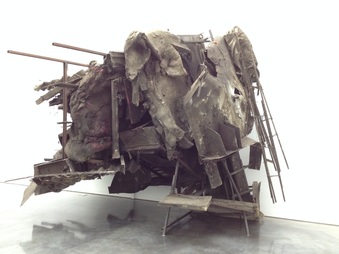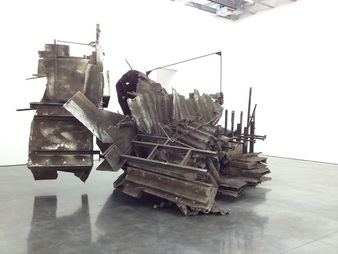 Peter Buggenhout, "The Blind Leading the Blind #67"
Peter Buggenhout, "The Blind Leading the Blind #67" My adult daughter hates contemporary art and accepts any opportunity to rail against it. Despite growing up with a working studio in our house and my regular reminders that I am a contemporary artist, she wants nothing to do with it. On a high school senior trip to Europe, she was forced to visit the Tate Modern which she equated with sitting through a root canal. Of course, it isn't really the contemporary part of the art that she doesn't like, it's the paucity of representational imagery: like many intelligent people unschooled in art, she thinks she is unable to read the artist's intent unless it resembles something she has already seen. Luckily, she is a history geek so her primary interests rarely force her to engage in the cultural present.
One of the most exciting finds in my gallery tour of New York last spring was an exhibition of two large sculptures by Belgian artist Peter Buggenhout at the Gladstone 21st St. Gallery. Similar to the Rudolf Stingel exhibition, walking into the Gladstone gallery was a jaw-dropping experience. But, unlike being overwhelmed by the awesome expanse of both the Gagosian gallery itself and Stingel's images, at Gladstone, you turn a corner into the gallery and are immediately confronted by a very large and hulking behemoth.
The sculpture is over 12 feet tall and almost as much in diameter. It is an assemblage of large cast-offs, grayed and worn by age and neglect. It's construction is animated and aggressive, almost violent, and it is situated on the floor more delicately than it should for it's size and bulk; it suggests agility. It is immediately intimidating and threatening. Just as you are over the shock of it, you realize that it has a brother in the gallery, different in detail but similar in intent.
One of the most exciting finds in my gallery tour of New York last spring was an exhibition of two large sculptures by Belgian artist Peter Buggenhout at the Gladstone 21st St. Gallery. Similar to the Rudolf Stingel exhibition, walking into the Gladstone gallery was a jaw-dropping experience. But, unlike being overwhelmed by the awesome expanse of both the Gagosian gallery itself and Stingel's images, at Gladstone, you turn a corner into the gallery and are immediately confronted by a very large and hulking behemoth.
The sculpture is over 12 feet tall and almost as much in diameter. It is an assemblage of large cast-offs, grayed and worn by age and neglect. It's construction is animated and aggressive, almost violent, and it is situated on the floor more delicately than it should for it's size and bulk; it suggests agility. It is immediately intimidating and threatening. Just as you are over the shock of it, you realize that it has a brother in the gallery, different in detail but similar in intent.
 Peter Buggenhout, "The Blind Leading the Blind #66"
Peter Buggenhout, "The Blind Leading the Blind #66" Despite arousing an acute awareness of one's vulnerability, the work is extremely compelling: I couldn't stop moving around and between the two heaps of industrial detritus. Large metal rods and planks cut through and extend from parts of large unrecognizable manufactured forms, overlaid at times with shrouds of unknown material under cakes of dust-like age, making it impossible to consider historical context. The work is simultaneously seductive and dangerous, like a potential lover or military campaign. Because of the grayness, the insistence on forms of demolition and destruction, and large scale of the pieces, I kept referencing the futility of war: maybe it was my heightened awareness of the World War I anniversary or maybe it was the palpable sense of violence, adrenaline and loss intrinsic in the piece. At any rate, it was a very powerful and exhausting experience.
Partially to goad her lack of interest in the activity and partially to simply stay in touch, I sent my daughter a picture of the sculpture with the caption, "Loving art in New York; wish you were here!" Her response was quick and terse; "Looks like something that washed up on the beaches of Normandy!"
I knew she meant it to be dismissive, but I smiled and said, "Yesss! She gets it!" Now we have to work on recognizing the value of "getting it".
Partially to goad her lack of interest in the activity and partially to simply stay in touch, I sent my daughter a picture of the sculpture with the caption, "Loving art in New York; wish you were here!" Her response was quick and terse; "Looks like something that washed up on the beaches of Normandy!"
I knew she meant it to be dismissive, but I smiled and said, "Yesss! She gets it!" Now we have to work on recognizing the value of "getting it".